| Botanical Name |
|
| Family |
Asteraceae - The daisy family. |
| Pronunciation |
YOO-ree-ops pek-tih-NAH-tus |
| Common Name(s) |
English: Golden Euryops; Golden Daisy Bush
|
| Plant Group |
- Shrub A woody plant of relatively low height, having several stems arising from the base and lacking a single trunk; a bush.
|
| Plant Size |
- Medium
| Tree | 10m to 16m |
| Shrub | 1m to 2m |
| Perennial/ground cover | 40cm to 60cm |
| Bulb | 40cm to 60cm |
| Succulent | 40cm to 60cm |
|
| Position |
- Light or Dappled Shade Found below trees with sparse, open foliage. Ideal for the protection of herbaceous plants.
- Partial Shade The area is in shade for part of the day and in full sun for part of the day.
- Sun The area is in full sun for all or most of the day, all year round.
|
| General Information |
- Drought Tolerance: Moderate The plant is moderately adapted to arid conditions and can survive short periods of drought and high temperatures without extra water.
- Evergreen Plants that have leaves all year round.
- Frost: Hardy The plant can withstand freezing temperatures or frost without artificial protection.
- Roots Non-invasive Safe to plant near pools, paving, walls or buildings.
- Sand tolerant Plants adapted to survive in nutrient poor, very sandy soils.
- Water Moderate These plants will need some extra watering compared to water-wise plants. Plant them together, in at least some shade and in a convenient proximity to the house so that grey water can be utilised during times of drought.
- Wind Tolerant Plants able to withstand the effect of strong winds.
|
| Specific Information |
This shrub has grey-green, fern-like foliage - a useful colour for the garden. Euryops pectinatus flowers best in full sun. It will tolerate light shade for all or part of the day but flowering will be reduced.
|
| Ad Break |
|
| Flowers |
| Description |
daisy flowers held on stems above the foliage
|
| Season |
- All Year Plants will seldom bloom for the entire season as given in the list, but should flower during a period within these parameters.
- Spring Plants will seldom bloom for the entire season as given in the list, but should flower during a period within these parameters.
|
| Colour |
|
| Growth Rate |
- Fast Specifying growth rate can be very misleading as there is considerable variation of growth rate depending on type and species of plant, available water, supplementary feeding, mulching and general care, as well as the plants suitability and adaptability to the garden environment.
|
| Plant Uses |
- Attracts bees, butterflies or other insects This plant attracts insects which can be food for birds or other creatures in your garden.
- Border A strip of ground, at the edge of a driveway or path in which ornamental plants or shrubs are planted.
- Boundary A plant useful for planting around the edges of the property to form a green or colourful backdrop, an impenetrable hedge, to hide walls or create privacy.
- Filler Either a fast growing tree or shrub used temporarily to fill in an area while the permanent plants grow to a desired size, or a plant used to fill gaps in borders or beds.
- Foliage Plant Plants grown because their foliage is colorful or unique. Many of these plants have insignificant flowers.
- Hedge Suitable trees or shrubs planted relatively close together so that the branches intertwine to create a barrier. This can be formal – the plants are regularly trimmed to produce a neat shape, or informal – the plants are left to themselves to create a natural hedgerow.
- Pioneer for new gardens A very fast growing plant, able to withstand hardship, that can be used to populate land that has recently been cleared of natural vegetation. These plants pave the way for slower-growing species by adding nutrients to the soil and creating leaf litter.
- Rock Garden An area constructed of larger rocks, arranged naturally, to emphasise the use of stones as a main element. Generally plants used do not need a lot of care.
- Stabilize Banks Plant is used to prevent soil erosion because their roots will form a mat that stabilizes the soil and keeps it from washing away in heavy rains.
- Suitable for coastal gardens Plants adapted to dry, sandy soil, forceful wind, limited rainfall and intense sunlight.
- Suitable for smaller gardens Such plants do not have invasive root systems, remain small or controllable and can often be grown in containers.
- Wild Garden An indigenous garden planted for the benefit of wildlife and birds. Provides food, water, a variety of mini-biomes and no poisonous chemicals are used.
|
| Distribution and Habitat |
from Piketberg to the South Peninsula in the south-western Cape, on rocky slopes
|
| Planting Suggestions |
Euryops pectinatus grows in most soils as long as they are well drained. Prepare a suitable hole, add fertiliser and compost, and mulch after planting. Water moderately and feed occasionally for fast growth and a profusion of flowers. Prune lightly after the main flowering period to encourage bushing. Cut back hard every few years to remove woody growth. In summer rainfall areas the plants should receive a moderate amount of water during winter. Remove dead heads to extend the flowering period.
|
| Lorraine's Garden Notes |
I tried the variegated hybrid of the species, but it was not robust enough to survive the harsh conditions of my garden. It was attacked by insects and suffered during dry periods, often looking unattractive.
|
| Medicinal Uses |
|
| Ad Break |
|


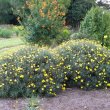
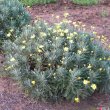
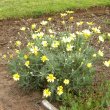
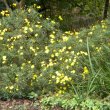
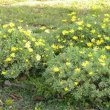


Discuss this plant
Share knowledge, ask a question or give an experience.